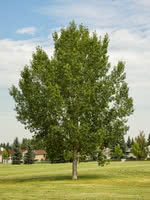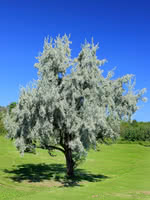Mon-Fri 9am - 5pm Mountain time
Northwest Poplar vs Russian Olive
Populus x jackii Northwest
Elaeagnus angustifolia
Northwest Poplar is a large and fast-growing tree. Due to its wide spread, this tree makes a great shade or shelterbelt tree. Northwest Poplar tolerates partial shade, drought, and most types of soil. This poplar produces no fuzz.
Northwest Poplar continues to be popular as a shelterbelt species due to the great cost savings that come from the wide spread of the branches. It is a staff favorite because of the wonderful shade it provides all summer long.
Russian Olive is a medium-sized deciduous tree that has attractive silvery coloured foliage with small yellow flowers that emit a fragrant sweet smell.
It is drought and salt tolerant, and works well as a shelterbelt species. Russian Olive can also be used to combat erosion.
Note: although Russian Olive is planted as an attractive boulevard tree in many northern areas, in warmer areas it can invade watersheds and is considered invasive. Please do some research and plant the right tree in the right place.
Northwest Poplar Quick Facts
Russian Olive Quick Facts
In row spacing: 2.4 - 3 m (8 - 10 ft)
In row spacing: 1.8 - 2.4 m (6 - 8 ft)

